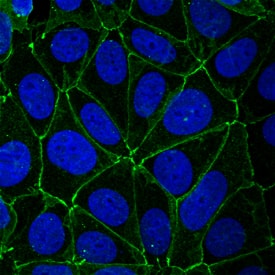Human JAM-A Antibody
R&D Systems, part of Bio-Techne | Catalog # AF1103


Key Product Details
Species Reactivity
Validated:
Cited:
Applications
Validated:
Cited:
Label
Antibody Source
Product Specifications
Immunogen
Ser28-Ala242
Accession # Q9Y624
Specificity
Clonality
Host
Isotype
Scientific Data Images for Human JAM-A Antibody
JAM‑A in MCF‑7 Human Cell Line.
JAM-A was detected in immersion fixed MCF-7 human breast cancer cell line using Goat Anti-Human JAM-A Antigen Affinity-purified Polyclonal Antibody (Catalog # AF1103) at 10 µg/mL for 3 hours at room temperature. Cells were stained using the NorthernLights™ 493-conjugated Anti-Goat IgG Secondary Antibody (green; Catalog # NL003) and counterstained with DAPI (blue). Specific staining was localized to intercellular junctions. View our protocol for Fluorescent ICC Staining of Cells on Coverslips.Applications for Human JAM-A Antibody
Immunocytochemistry
Sample: Immersion fixed MCF‑7 human breast cancer cell line
Immunohistochemistry
Sample: Immersion fixed paraffin-embedded sections of human lung
Western Blot
Sample: Recombinant Human JAM-A Fc Chimera (Catalog # 1103-JM)
Reviewed Applications
Read 2 reviews rated 5 using AF1103 in the following applications:
Formulation, Preparation, and Storage
Purification
Reconstitution
Formulation
Shipping
Stability & Storage
- 12 months from date of receipt, -20 to -70 °C as supplied.
- 1 month, 2 to 8 °C under sterile conditions after reconstitution.
- 6 months, -20 to -70 °C under sterile conditions after reconstitution.
Background: JAM-A
The family of junctional adhesion molecules (JAM), comprising at least three members, are type I transmembrane receptors belonging to the immunoglobulin (Ig) superfamily (1, 2). These proteins are localized in the tight junctions between endothelial or epithelial cells. Some family members are also found on blood leukocytes and platelets. Human JAM-A, also known as platelet adhesion molecule 1 (PAM-1) and platelet F11 receptor (3), is predominantly expressed at intercellular junctions of both epithelial cells and endothelial cells (1‑4). It is also expressed on circulating blood cells including neutrophils, monocytes, platelets, erythrocytes and lymphocytes (5). Human JAM-A cDNA predicts a 299 amino acid (aa) residue precursor protein with a putative 27 aa signal peptide, a 210 aa extracellular region containing two Ig‑like V-subset domains, a 24 aa transmembrane domain and a 38 aa cytoplasmic domain. The human and mouse proteins share approximately 67% aa sequence homology. Human JAM-A also shares approximately 35% and 32% aa sequence homology with human JAM-B and JAM-C, respectively. JAM-A exhibits homophilic interactions to regulate tight junction assembly and modulate paracellular permeability. This homophilic interation also mediates platelet aggregation and adhesion to endothelial cells and may play a role in thrombosis (3). JAM-A binds heterotypically with the beta2 integrin lymphocyte function-associated antigen-1 (LFA-1). This JAM‑A‑LFA‑1 interaction is involved in leukocyte adhesion and transmigration (6). JAM-A has also been shown to bind reovirus attachment protein sigma-1 to permit reovirus infection and signal virus-induced apoptosis (7).
References
- Chavakis, T. et al. (2003) Thromb. Haemost. 89:13.
- Aurand-Lions, M. et al. (2001) Blood 98:3699.
- Sobocka, M.B. et al. (2000) Blood 95:2600.
- Martin-Padura, I. et al. (1998) J. Cell Biol. 142:117.
- Williams, L.A. et. al. (1999) Mol. Immunol. 36:1175.
- Ostermann, G. et al. (2002) Nature Immunol. 3:151.
- Barton, E.S. et al. (2001) Cell 104:441.
Long Name
Alternate Names
Gene Symbol
UniProt
Additional JAM-A Products
Product Documents for Human JAM-A Antibody
Product Specific Notices for Human JAM-A Antibody
For research use only